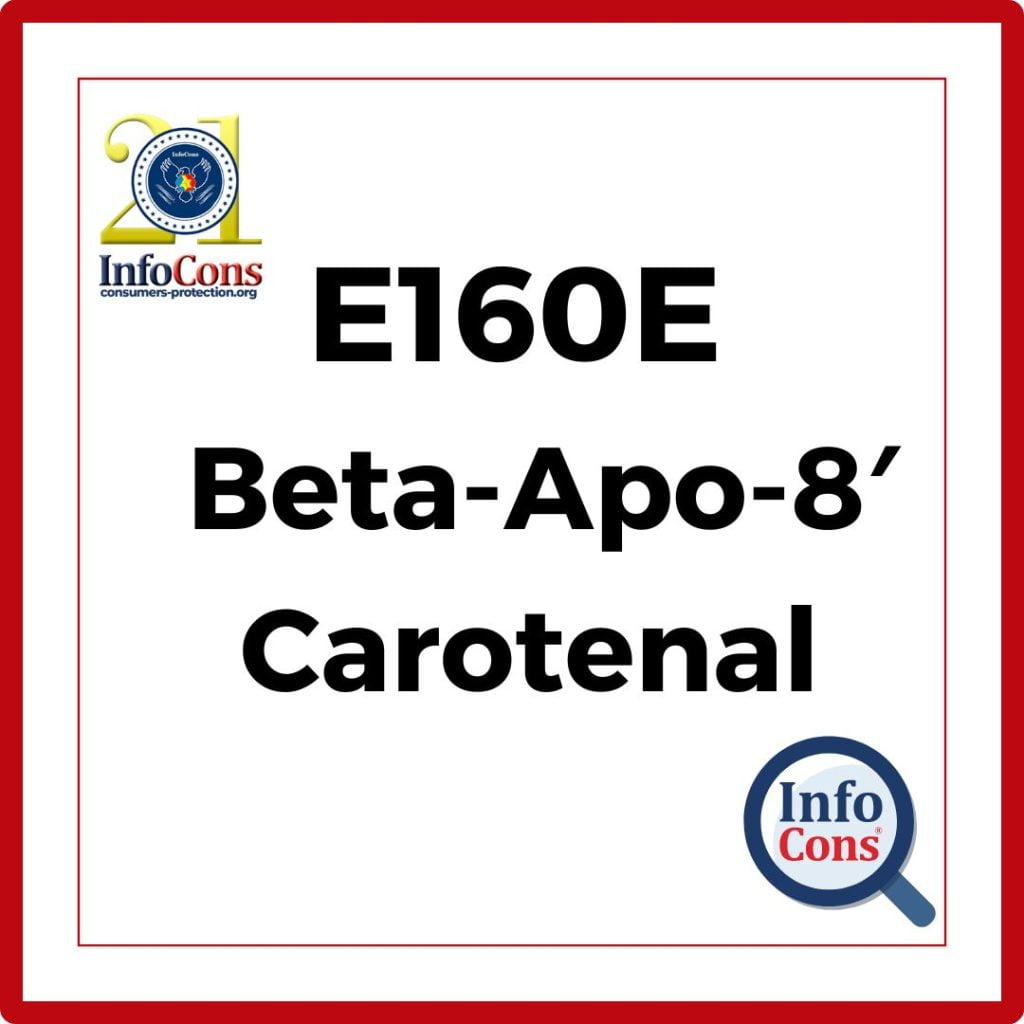
What is Food Additive E160E ?
E160E is a food additive from the category of natural colorants, derived from carotene or isolated from plants.
The food additive E160E, also known as beta-apo-8′-carotenal, is a widely used food colorant in the food industry. It provides an orange to reddish hue to a variety of products, enhancing their visual appeal and indicating flavor profiles that are often associated with the colors it produces.
Carotenoids are known for their vibrant colors and antioxidant properties. E160E is a specific derivative of beta-carotene, differing by the presence of an aldehyde group at one end of the molecule, which gives it unique color and solubility characteristics. Its molecular formula is C6H10O5, and it is soluble in fats and oils, slightly soluble in water.
Read also – E160C – Capsanthin (Paprika)
What is the Recommended Daily Dose?
The safety of the food additive E160E has been evaluated by various regulatory agencies around the world. E160E is generally recognized as safe for consumers and is permitted for use within specified limits.
The European Union (EU) and the United States Food and Drug Administration (FDA) list beta-apo-8′-carotenal as a safe color additive, with permissible limits established for different types of food.
In Europe, the European Food Safety Authority (EFSA) has approved an acceptable daily intake (ADI) of 0-5 mg/kg body weight per day.
Read also – E160B – Annatto
In Which Products is E160E Found ?
E160E is used for its coloring properties in a wide range of food products. Its vibrant color and stability make it a preferred choice for a variety of products:
- Beverages: In fruit-flavored drinks, soft drinks, and powdered beverage mixes to impart a bright and attractive color.
- Dairy Products: In cheese, butter, and margarine to achieve consistent coloring.
- Confectionery: In candies, gummies, and other sweets where a vivid color is desired.
- Bakery Products: In cakes, biscuits, and other baked goods to enhance their visual appeal.
Read also – E160D – Lycopene
Contraindications and Risks
In general, E160E is considered safe for most consumers if the recommended amounts are observed.
Apart from its coloring properties, E160E, like other carotenoids, may have potential health benefits. Carotenoids are known for their antioxidant activity, which helps neutralize free radicals and protect cells from oxidative damage.
However, there are studies showing that β-carotene supplementation increases the risk of lung cancer in smokers, regardless of the tar or nicotine content of the cigarettes smoked. Because supplementation with large amounts of β-carotene may increase cancer risk in smokers, it is believed that excess E160E can break down into compounds that reduce vitamin A levels and worsen the effects of smoke on lung cells.
Higher doses can lead to yellowing of the skin, dryness of the lips, nasal mucosa, and eyes. Long-term administration of large doses can trigger symptoms specific to hypervitaminosis A (skin and liver disorders, hair loss in children, bone damage, headaches, vomiting, and diplopia). In pregnant women, it can cause fetal malformations, particularly affecting the nervous system.
Read also : How to Choose Fruits and Vegetables at the Store
Conclusions
Although considered safe if consumed in recommended doses, if you want to limit your intake of E160E from your diet, you can read the labels of food products carefully: E160E will be listed in the ingredients section under its code or name.
Look for products with cleaner labels or those using natural additives. By installing the InfoCons App and scanning the barcodes of food products, you can find out the number and type of food additives in the app.
As with any food additive, it is important to observe the recommended daily amounts.
Understanding the properties and applications of this food additive helps in appreciating its role in modern food technology and consumer health. As research progresses, we can expect to see continued innovations in the use and production of such natural food additives.
By installing the InfoCons app and scanning the barcodes of food products, you can find out the number and type of food additives used.
Author – Cosmina Nițu
Master in Nutrition – Infant and new born nutrition
Sources:
https://www.ncbi.nlm.nih.gov/ – National Center for Biotechnology Information
https://www.efsa.europa.eu- European Food Safety Authority (EFSA)
InfoCons – European Organization for Consumers Protection and Promotion of Programs and Strategies , a full member of the World Organization Consumers International, founding member of the Federation of Consumer Associations, and member of ANEC.